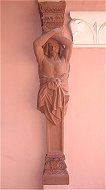CaryatidDefinition: The generally accepted definition of a caryatid (also spelt Karyatid) is: a sculpted female figure serving as an architectural support taking the place of a column or a pillar supporting an entablature on her head. However, here you see a male example. Also in Ruben's modello of "Thetis dipping Achilles into the river Styx" there is a male caryatid: Pluto. |
Subject info:
Some of the earliest known examples were found in the treasuries of Delphi, dating to
about the 6th century BC, but their use as supports in the form of female figures can be
traced back even farther, to ritual basins, ivory mirror handles from Phoenicia, and
draped figures from archaic Greece. The best-known and most-copied examples are those of
the six figures of the Caryatid Porch of the Erechtheion on the Acropolis at Athens
(illustration, right).
One of those original six figures, removed by Lord Elgin in the early 1800s, is now in the
British Museum in London. The other five figures, although they are damaged by erosion,
are in the Acropolis Museum.
The Romans also copied the Erechtheion caryatids, installing copies in the Forum of
Augustus and the Pantheon in Rome, and Hadrian's Villa at Tivoli.
In modern times, the practice of integrating caryatids into building facades was revived
in the later 16th century and, from the examples engraved for Sebastiano Serlio's treatise
on architecture, became a fixture in the decorative vocabulary of Northern Mannerism
expressed by the Fontainebleau School and the engravers of designs in Antwerp. Caryatids
remained part of the German Baroque vocabulary (illustration, right) and were refashioned
in more restrained and "Grecian" forms by neoclassical architects and designers.
In the early 17th century interior examples appear in Europe, such as the overmantle in
the great hall of Muchalls Castle in Scotland. In exterior architecture, among the most
famous examples is the copy of the porch on the 1822 Saint Pancras Church in London, which
includes four terra cotta figures, and the many caryatids lined up on the facade of the
1893 Museum of Science and Industry in Chicago. In the arts of design, the draped figure
supporting an acanthus-grown basket capital taking the form of a candlestick or a
table-support is a familiar clich of neoclassical decorative arts.
The origins of the term are unclear. It is first recorded in the Latin form caryatides by
the Roman architect Vitruvius. He stated in his 1st century BC work De architectura that
the female figures of the Erechtheion represented the punishment of the women of Caryae
(Greek Karyiai), a town near Sparta in Laconia, who were condemned to slavery after
betraying Athens by siding with Persia in the Greco-Persian Wars. The Greek term
karuatides literally means "maidens of Karuai" or Caryae.
However, Vitruvius' explanation is doubtful; well before the Persian Wars, female figures
were used as decorative supports in Greece and the ancient Near East. Karyai had a famous
temple dedicated to the goddess Artemis in her aspect of Artemis Karyatis: "As
Karyatis she rejoiced in the dances of the nut-tree village of Karyai, those Karyatides
who in their ecstatic round-dance carried on their heads baskets of live reeds, as if they
were dancing plants" (Kerenyi 1980 p 149).
A caryatid supporting a basket on her head is called a canephora
("basket-bearer"), representing one of the maidens who carried sacred objects
used at feasts of the gods. The Erectheion caryatids, in a shrine dedicated to an archaic
king of Athens, may therefore represent priestesses of Artemis in a place named for the
"nut-tree sisterhood" – apparently in Mycenaean times, like other plural
feminine toponyms, such as Hyrai or Athens itself.
The male counterpart of a caryatid is referred to as a telemon (plural telemones) or Atlas
(plural, atlantes) – the name refers to the legend of Atlas, who bore the sphere of
the heavens on his shoulders. Such figures were used on a monumental scale, notably in the
Temple of Olympian Zeus in Agrigento, Sicily.
